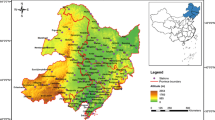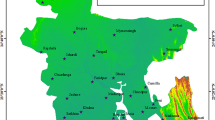Abstract
Drought, which has become one of the most severe environmental problems worldwide, has serious impacts on ecological, economic, and socially sustainable development. The drought monitoring process is essential in the management of drought risks, and drought index calculation is critical in the tracking of drought. The Palmer Drought Severity Index is one of the most widely used methods in drought calculation. The drought calculation according to Palmer is a time-consuming process. Such a troublesome can be made easier using advanced machine learning algorithms. Therefore, in this study, the advanced machine learning algorithms (LR, ANN, SVM, and DT) were employed to calculate and estimate the Palmer drought Z-index values from the meteorological data. Palmer Z-index values, which will be used as training data in the classification process, were obtained through a special-purpose software adopting the classical procedure. This special-purpose software was developed within the scope of the study. According to the classification results, the best R-value (0.98) was obtained in the ANN method. The correlation coefficient was 0.98, Mean Squared Error was 0.40, and Root Mean Squared Error was 0.56 in this success. Consequently, the findings showed that drought calculation and prediction according to the Palmer Index could be successfully carried out with advanced machine learning algorithms.

Graphical Abstract









Similar content being viewed by others
References
Alam, N. M., Sharma, G. C., Moreira, E., Jana, C., Mishra, P. K., Sharma, N. K., & Mandal, D. (2017). Evaluation of drought using SPEI drought class transitions and log-linear models for different agro-ecological regions of India. Physics and Chemistry of the Earth, 100, 31–43. https://doi.org/10.1016/j.pce.2017.02.008.
Ali, Z., Hussain, I., Faisal, M., Nazir, H. M., Hussain, T., Shad, M. Y., Shoukry, A. M., & Gani, S. H. (2017). Forecasting drought using multilayer perceptron artificial neural network model. Advances in Meteorology. https://doi.org/10.1155/2017/5681308.
Basakin, E. E., Ekmekcioglu, O., & Ozger, M. (2019). Drought analysis with machine learning methods. Pamukkale University Journal of Engineering Sciences, 25, 985–991. https://doi.org/10.5505/pajes.2019.34392.
Briggs, L. J., & Shantz, H. (1912). The wilting coefficient and its indirect determination. Botanical Gazette, 53, 20–37.
Çelik, A., İnan, M., Sakin, E., Büyük, G., Kırpık, M., & Akça, E. (2017). Changes in soil properties following shifting from rainfed to irrigated agriculture: The Adıyaman case. Toprak Bilimi ve Bitki Besleme Dergisi, 5, 80–86.
Choubin, B., Khalighi-Sigaroodi, S., Malekian, A., Ahmad, S., & Attarod, P. (2014). Drought forecasting in a semi-arid watershed using climate signals: A neuro-fuzzy modeling approach. Journal of Mountain Science-England, 11, 1593–1605.
Choubin, B., Malekian, A., & Golshan, M. (2016). Application of several data-driven techniques to predict a standardized precipitation index. Atmósfera, 29, 121–128.
Cortes, C., & Vapnik, V. (1995). Support-vector networks. Machine Learning, 20, 273–297. https://doi.org/10.1007/Bf00994018.
Cui, L. F., Wang, L. C., Lai, Z. P., Tian, Q., Liu, W., & Li, J. (2017). Innovative trend analysis of annual and seasonal air temperature and rainfall in the Yangtze River Basin, China during 1960-2015. Journal of Atmospheric and Solar - Terrestrial Physics, 164, 48–59. https://doi.org/10.1016/j.jastp.2017.08.001.
DSİ (2014) General Directory of State Hydraulic Works, Atatürk Dam Reservoir. http://www.dsi.gov.tr/projeler/ataturk-baraji. Accessed 18 April 2020
Feng, P. Y., Wang, B., Liu, D. L., & Yu, Q. (2019). Machine learning-based integration of remotely-sensed drought factors can improve the estimation of agricultural drought in South-Eastern Australia. Agricultural Systems, 173, 303–316. https://doi.org/10.1016/j.agsy.2019.03.015.
GDWM (2018) Van Lake Basin drought management plan volume-I: General description of the basin and drought analysis vol 1. Flood and Drought Management Department, General Directorate of Water Management (GDWM), T. R. Ministry of Agriculture and Forestry, Ankara.
Gunaydin, O., Ozbeyaz, A., & Soylemez, M. (2019). Estimating California bearing ratio using decision tree regression analysis using soil index and compaction parameters international. Journal of Intelligent Systems and Applications in Engineering, 7, 30–33.
Hao, Z. C., Hao, F. H., Singh, V. P., Ouyang, W., & Cheng, H. G. (2017). An integrated package for drought monitoring, prediction and analysis to aid drought modeling and assessment. Environmental Modelling and Software, 91, 199–209. https://doi.org/10.1016/j.envsoft.2017.02.008.
IPCC. (2014). Climate Change 2014. Impacts, adaptation, and vulnerability. Cambridge: Cambridge University Press.
Kisi, O., Choubin, B., Deo, R. C., & Yaseen, Z. M. (2019). Incorporating synoptic-scale climate signals for streamflow modelling over the Mediterranean region using machine learning models. Hydrological Sciences Journal, 64, 1240–1252.
Li, Y. W., Tang, G. C., Du, J. M., Zhou, N., Zhao, Y., & Wu, T. (2019). Multilayer perceptron method to estimate real-world fuel consumption rate of light duty vehicles. Ieee Access, 7, 63395–63402. https://doi.org/10.1109/Access.2019.2914378.
Liu, Y., Zhu, Y., Ren, L. L., Singh, V. P., Yang, X. L., & Yuan, F. (2017). A multiscalar Palmer drought severity index. Geophysical Research Letters, 44, 6850–6858. https://doi.org/10.1002/2017GL073871.
Liu Q, Zhang S, Zhang H, Bai Y, Zhang J (2019) Monitoring drought using composite drought indices based on remote sensing Sci Total Environ 134585.
Ma, M. W., Ren, L. L., Singh, V. P., Yuan, F., Chen, L., Yang, X. L., & Liu, Y. (2016). Hydrologic model-based Palmer indices for drought characterization in the Yellow River basin, China. Stochastic Environmental Research and Risk Assessment, 30, 1401–1420. https://doi.org/10.1007/s00477-015-1136-z.
McKee TB, Doesken NJ, Kleist J (1993) The relationship of drought frequency and duration to time scales. In: Proceedings of the 8th Conference on Applied Climatology. vol 22. American Meteorological Society Boston, MA, pp 179–183
Meenal, R., & Selvakumar, A. I. (2018). Assessment of SVM, empirical and ANN based solar radiation prediction models with most influencing input parameters. Renewable Energy, 121, 324–343. https://doi.org/10.1016/j.renene.2017.12.005.
Mehr, A. D., Kahya, E., & Ozger, M. (2014). A gene-wavelet model for long lead time drought forecasting. Journal of Hydrology, 517, 691–699. https://doi.org/10.1016/j.jhydrol.2014.06.012.
Mika, J., Horvath, S., Makra, L., & Dunkel, Z. (2005). The Palmer Drought Severity Index (PDSI) as an indicator of soil moisture. Physics and Chemistry of the Earth, 30, 223–230. https://doi.org/10.1016/j.pce.2004.08.036.
Mishra, A. K., & Singh, V. P. (2011). Drought modeling - A review. Journal of Hydrology, 403, 157–175. https://doi.org/10.1016/j.jhydrol.2011.03.049.
Mo, K. C., & Chelliah, M. (2006). The modified Palmer drought severity index based on the NCEP North American Regional Reanalysis. Journal of Applied Meteorology and Climatology, 45, 1362–1375. https://doi.org/10.1175/Jam2402.1.
Nourani, V., & Molajou, A. (2017). Application of a hybrid association rules/decision tree model for drought monitoring. Global and Planetary Change, 159, 37–45. https://doi.org/10.1016/j.gloplacha.2017.10.008.
Olukayode Oladipo, E. (1985). A comparative performance analysis of three meteorological drought indices. Journal of Climatology, 5, 655–664.
Ozger, M., Mishra, A. K., & Singh, V. P. (2012). Long lead time drought forecasting using a wavelet and fuzzy logic combination model: A case study in Texas. Journal of Hydrometeorology, 13, 284–297. https://doi.org/10.1175/Jhm-D-10-05007.1.
Palmer W (1965) Meteorological drought, Research Paper No 45, US Weather Bureau, Washington, DC, 1965.:1-59
Parry, S., Wilby, R. L., Prudhomme, C., & Wood, P. J. (2016). A systematic assessment of drought termination in the United Kingdom. Hydrology and Earth System Sciences, 20, 4265–4281. https://doi.org/10.5194/hess-20-4265-2016.
Rao, A. R., & Padmanabhan, G. (1984). Analysis and modeling of Palmer’s drought index series. Journal of Hydrology, 68, 211–229.
Rhee, J., & Im, J. (2017). Meteorological drought forecasting for ungauged areas based on machine learning: Using long-range climate forecast and remote sensing data. Agricultural and Forest Meteorology, 237, 105–122. https://doi.org/10.1016/j.agrformet.2017.02.011.
Roodposhti, M. S., Safarrad, T., & Shahabi, H. (2017). Drought sensitivity mapping using two one-class support vector machine algorithms. Atmospheric Research, 193, 73–82. https://doi.org/10.1016/j.atmosres.2017.04.017.
Sigaroodi, S. K., Chen, Q., Ebrahimi, S., Nazari, A., & Choobin, B. (2014). Long-term precipitation forecast for drought relief using atmospheric circulation factors: A study on the Maharloo Basin in Iran. Hydrology and Earth System Sciences, 18, 1995.
Thornthwaite, C. W. (1948). An approach toward a rational classification of climate. Geographical Review, 38, 55–94.
Tirivarombo, S., Osupile, D., & Eliasson, P. (2018). Drought monitoring and analysis: Standardised Precipitation Evapotranspiration Index (SPEI) and Standardised Precipitation Index (SPI). Physics and Chemistry of the Earth, 106, 1–10. https://doi.org/10.1016/j.pce.2018.07.001.
Tufaner F, Dabanlı İ (2018) Adıyaman İlinde Kuraklık Takibi. Paper presented at the Uluslararası Su ve Çevre Kongresi SUÇEV, Bursa - Türkiye, 22-24 Mart 2018.
Vicente-Serrano, S. M., Begueria, S., & Lopez-Moreno, J. I. (2010). A multiscalar drought index sensitive to global warming: The standardized precipitation evapotranspiration. Index Journal of Climate, 23, 1696–1718. https://doi.org/10.1175/2009JCLI2909.1.
Wanders N, Van Loon AF, Van Lanen HA (2017) Frequently used drought indices reflect different drought conditions on global scale. Hydrol Earth Syst Sci Discuss 1–16
Wang, M., Gu, Q. X., Jia, X. J., & Ge, J. W. (2019). An assessment of the impact of Pacific Decadal Oscillation on autumn droughts in North China based on the Palmer drought severity index. International Journal of Climatology, 39, 5338–5350. https://doi.org/10.1002/joc.6158.
Webb RW, Rosenzweig CE, Levine ER (2000) Global soil texture and derived water-holding capacities. Data set. Available on-line [http://www.daac.ornl.gov] from Oak Ridge National Laboratory Distributed Active Archive Center, Oak Ridge, Tennessee, U.S.A. doi:https://doi.org/10.3334/ORNLDAAC/548.
Wells, N., Goddard, S., & Hayes, M. J. (2004). A self-calibrating Palmer Drought Severity Index. Journal of Climate, 17, 2335–2351. https://doi.org/10.1175/1520-0442(2004)017<2335:Aspdsi>2.0.Co;2.
Yan, D. H., Shi, X. L., Yang, Z. Y., Li, Y., Zhao, K., & Yuan, Y. (2013). Modified Palmer drought severity index based on distributed hydrological simulation math. Problems in Engineering. https://doi.org/10.1155/2013/327374.
Yang, M. Z., Xiao, W. H., Zhao, Y., Li, X. D., Lu, F., Lu, C. Y., & Chen, Y. (2017). Assessing agricultural drought in the anthropocene: A modified Palmer drought severity index. Water-Sui, 9, 9. https://doi.org/10.3390/W9100725.
Yu, H. Q., Zhang, Q., Xu, C. Y., Du, J., Sun, P., & Hu, P. (2019). Modified Palmer Drought Severity Index: Model improvement and application. Environment International, 130, 130. https://doi.org/10.1016/J.Envint.2019.104951.
Zhang, R., Chen, Z. Y., Xu, L. J., & Ou, C. Q. (2019). Meteorological drought forecasting based on a statistical model with machine learning techniques in Shaanxi province. China Science of the Total Environment, 665, 338–346. https://doi.org/10.1016/j.scitotenv.2019.01.431.
Author information
Authors and Affiliations
Corresponding author
Additional information
Publisher’s note
Springer Nature remains neutral with regard to jurisdictional claims in published maps and institutional affiliations.
Highlights
• The Palmer Drought Severity Index (PDSI) was modeled to reduce mathematical computational complexity through four machine learning algorithms (LR, ANN, SVM, and DT).
• In the studied models, the meteorological variables were used as input data.
• Palmer’s drought computing approach has been re-coded in the Matlab environment. And runoff (RO) and Palmer Index data were obtained by using this software.
• In the study, the best correlation coefficient was obtained in the ANN algorithm with 0.98. The MSE value was 0.40 at this success.
• A novel training data using meteorological variables were developed and shared online.
• By using the developed training data, Palmer drought index values for other regions will be able to be calculated by researchers easily.
Electronic supplementary material
ESM 1
(XLSX 36 kb)
Rights and permissions
About this article
Cite this article
Tufaner, F., Özbeyaz, A. Estimation and easy calculation of the Palmer Drought Severity Index from the meteorological data by using the advanced machine learning algorithms. Environ Monit Assess 192, 576 (2020). https://doi.org/10.1007/s10661-020-08539-0
Received:
Accepted:
Published:
DOI: https://doi.org/10.1007/s10661-020-08539-0




